 |
 |
Our enthusiastic and extremely knowledgeable perennials team is here to answer your questions and help you choose the best perennials for your situation. There’s always something in bloom for sun, shade, butterflies, birds or deer resistance as well as a variety of bulbs for your space.
Stroll through our time-tested favorites and introduce yourself to the newest varieties. We garden with perennials too; we love them and it shows!
|
605 found, showing page 9 of 41
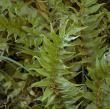
Upright light green tapered fronds. Naturalizing.USDA 4-9
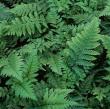
Grayish-green, deeply cut, leathery fronds. Easily grown in average, medium, well-drained soil. USDA 3-8
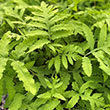
Tolerates moisture, Clay, rabbits, & deep Shade. Naturalizing. USDA 4-8
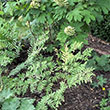
Rich-green, rounded foliage. Slow to spread. USDA 3-9
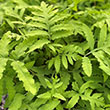
Height: 24 inches
Spread: 24 inches
Sunlight: partial shade, full shade
Hardiness Zone: 2b
Other Names: Bead Fern
Description:
Touch this plant and the tender leaflets close, hence the the name; this ferny gem is readily propagated by spores living in large colonies, however it is short lived in each location
Ornamental Features:
Sensitive Fern is primarily valued in the garden for its ornamental upright and spreading habit of growth. Its serrated ferny bipinnately compound leaves remain light green in color throughout the season.
Landscape Attributes:
Sensitive Fern is an herbaceous fern with an upright spreading habit of growth. Its relatively fine texture sets it apart from other garden plants with less refined foliage.
This is a high maintenance plant that will require regular care and upkeep, and is best cleaned up in early spring before it resumes active growth for the season. Gardeners should be aware of the following characteristic(s) that may warrant special consideration:
- Invasive
Sensitive Fern is recommended for the following landscape applications:
- Groundcover
- Naturalizing And Woodland Gardens
- Bog Gardens
Planting & Growing:
Sensitive Fern will grow to be about 24 inches tall at maturity, with a spread of 24 inches. It grows at a fast rate, and under ideal conditions can be expected to live for approximately 10 years. As an herbaceous perennial, this plant will usually die back to the crown each winter, and will regrow from the base each spring. Be careful not to disturb the crown in late winter when it may not be readily seen!
This plant does best in partial shade to shade. It prefers to grow in moist to wet soil, and will even tolerate some standing water. It is not particular as to soil type, but has a definite preference for acidic soils. It is somewhat tolerant of urban pollution. Consider applying a thick mulch around the root zone over the growing season to conserve soil moisture. This species is native to parts of North America, and parts of it are known to be toxic to humans and animals, so care should be exercised in planting it around children and pets. It can be propagated by division.
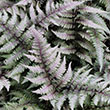
Striking, silvery-green foliage with blue tones. Large, clumping variety. USDA 3-8
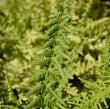
Height: 3 feet
Spread: 3 feet
Sunlight: partial shade, full shade
Hardiness Zone: 4b
Other Names: Black Wood Fern, Shaggy Wood Fern
Description:
A rosette-forming variety with a neat appearance, evenly toothed and lobed fronds on scaly stalks; attractive fiddleheads unfurl in spring; evergreen in milder areas; keep evenly moist, provides habitat and shelter for birds and bees
Ornamental Features:
Shaggy Shield Fern is primarily valued in the garden for its cascading habit of growth. Its serrated ferny compound leaves remain green in color throughout the year.
Landscape Attributes:
Shaggy Shield Fern is an herbaceous evergreen fern with a shapely form and gracefully arching fronds. It brings an extremely fine and delicate texture to the garden composition and should be used to full effect.
This is a relatively low maintenance plant, and should be cut back in late fall in preparation for winter. Deer don't particularly care for this plant and will usually leave it alone in favor of tastier treats. It has no significant negative characteristics.
Shaggy Shield Fern is recommended for the following landscape applications:
- Mass Planting
- General Garden Use
- Naturalizing And Woodland Gardens
Planting & Growing:
Shaggy Shield Fern will grow to be about 3 feet tall at maturity, with a spread of 3 feet. Its foliage tends to remain dense right to the ground, not requiring facer plants in front. It grows at a medium rate, and under ideal conditions can be expected to live for approximately 15 years. As an evegreen perennial, this plant will typically keep its form and foliage year-round. As this plant tends to go dormant in summer, it is best interplanted with late-season bloomers to hide the dying foliage.
This plant does best in partial shade to shade. It prefers to grow in average to moist conditions, and shouldn't be allowed to dry out. It is particular about its soil conditions, with a strong preference for rich, acidic soils. It is somewhat tolerant of urban pollution. Consider applying a thick mulch around the root zone over the growing season to conserve soil moisture. This species is not originally from North America, and parts of it are known to be toxic to humans and animals, so care should be exercised in planting it around children and pets. It can be propagated by division.
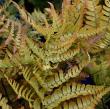
Height: 18 inches
Spread: 18 inches
Sunlight: partial shade, full shade
Hardiness Zone: 4b
Other Names: Japanese Red Shield Fern
Description:
Lovely deep green fronds; fiddleheads and fronds emerge copper colored; great woodland and shade garden plant; keep evenly moist
Ornamental Features:
Brilliance Autumn Fern is primarily valued in the garden for its cascading habit of growth. Its attractive glossy ferny compound leaves emerge coral-pink in spring, turning forest green in color with prominent coppery-bronze tips the rest of the year.
Landscape Attributes:
Brilliance Autumn Fern is a dense herbaceous evergreen fern with a shapely form and gracefully arching fronds. It brings an extremely fine and delicate texture to the garden composition and should be used to full effect.
This is a relatively low maintenance plant, and should be cut back in late fall in preparation for winter. Deer don't particularly care for this plant and will usually leave it alone in favor of tastier treats. It has no significant negative characteristics.
Brilliance Autumn Fern is recommended for the following landscape applications:
- Mass Planting
- Rock/Alpine Gardens
- Border Edging
- General Garden Use
- Groundcover
- Naturalizing And Woodland Gardens
Planting & Growing:
Brilliance Autumn Fern will grow to be about 18 inches tall at maturity, with a spread of 18 inches. Its foliage tends to remain dense right to the ground, not requiring facer plants in front. It grows at a medium rate, and under ideal conditions can be expected to live for approximately 15 years. As an evegreen perennial, this plant will typically keep its form and foliage year-round.
This plant does best in partial shade to shade. It is quite adaptable, prefering to grow in average to wet conditions, and will even tolerate some standing water. It is particular about its soil conditions, with a strong preference for rich, acidic soils. It is somewhat tolerant of urban pollution, and will benefit from being planted in a relatively sheltered location. Consider applying a thick mulch around the root zone over the growing season to conserve soil moisture.
This is a selected variety of a species not originally from North America, and parts of it are known to be toxic to humans and animals, so care should be exercised in planting it around children and pets. It can be propagated by division; however, as a cultivated variety, be aware that it may be subject to certain restrictions or prohibitions on propagation.
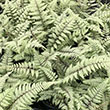
Upright silvery foliage. Maroon midribs. Tolerates seep shade. USDA 4-8
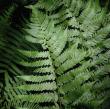
Height: 4 feet
Spread: 3 feet
Sunlight: partial shade, full shade
Hardiness Zone: 4b
Description:
This tall fern is a great vertical accent; has graceful, arching fronds; keep evenly moist, provides habitat and shelter for birds and bees.
Ornamental Features:
Dixie Wood Fern is primarily valued in the landscape or garden for its cascading habit of growth. Its tiny ferny compound leaves remain green in color throughout the year.
Landscape Attributes:
Dixie Wood Fern is an herbaceous evergreen fern with a shapely form and gracefully arching fronds. It brings an extremely fine and delicate texture to the garden composition and should be used to full effect.
This is a relatively low maintenance plant, and should be cut back in late fall in preparation for winter. Deer don't particularly care for this plant and will usually leave it alone in favor of tastier treats. It has no significant negative characteristics.
Dixie Wood Fern is recommended for the following landscape applications:
- Mass Planting
- General Garden Use
- Naturalizing And Woodland Gardens
Planting & Growing:
Dixie Wood Fern will grow to be about 4 feet tall at maturity, with a spread of 3 feet. Its foliage tends to remain dense right to the ground, not requiring facer plants in front. It grows at a medium rate, and under ideal conditions can be expected to live for approximately 15 years. As an evegreen perennial, this plant will typically keep its form and foliage year-round. As this plant tends to go dormant in summer, it is best interplanted with late-season bloomers to hide the dying foliage.
This plant does best in partial shade to shade. It prefers to grow in average to moist conditions, and shouldn't be allowed to dry out. It is particular about its soil conditions, with a strong preference for rich, acidic soils. It is somewhat tolerant of urban pollution, and will benefit from being planted in a relatively sheltered location. Consider applying a thick mulch around the root zone over the growing season to conserve soil moisture. This particular variety is an interspecific hybrid, and parts of it are known to be toxic to humans and animals, so care should be exercised in planting it around children and pets. It can be propagated by division; however, as a cultivated variety, be aware that it may be subject to certain restrictions or prohibitions on propagation.
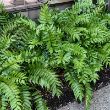
Height: 24 inches
Spread: 18 inches
Sunlight: partial shade, full shade
Hardiness Zone: 4b
Other Names: Hardy Holly Fern
Description:
The lovely, leathery, glossy fronds of this bold fern resemble those of a holly; keep moist but soil should be well-drained; cut back fronds as they get damaged; tolerates some sun; dies back to ground in colder climates
Ornamental Features:
Japanese Holly Fern is primarily valued in the garden for its cascading habit of growth. Its attractive glossy ferny leaves remain dark green in color throughout the year.
Landscape Attributes:
Japanese Holly Fern is an herbaceous evergreen fern with a shapely form and gracefully arching fronds. Its relatively fine texture sets it apart from other garden plants with less refined foliage.
This is a relatively low maintenance plant, and is best cleaned up in early spring before it resumes active growth for the season. It has no significant negative characteristics.
Japanese Holly Fern is recommended for the following landscape applications:
- Mass Planting
- Rock/Alpine Gardens
- Border Edging
- General Garden Use
- Naturalizing And Woodland Gardens
Planting & Growing:
Japanese Holly Fern will grow to be about 24 inches tall at maturity, with a spread of 18 inches. Its foliage tends to remain dense right to the ground, not requiring facer plants in front. It grows at a medium rate, and under ideal conditions can be expected to live for approximately 10 years. As an evegreen perennial, this plant will typically keep its form and foliage year-round.
This plant does best in partial shade to shade. It does best in average to evenly moist conditions, but will not tolerate standing water. It is particular about its soil conditions, with a strong preference for rich, acidic soils. It is somewhat tolerant of urban pollution. Consider applying a thick mulch around the root zone in both summer and winter to conserve soil moisture and protect it in exposed locations or colder microclimates. This species is not originally from North America. It can be propagated by division.
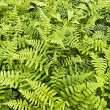
FERN 'GOLDEN SCALED MALED' 1QT
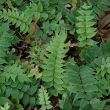
Height: 24 inches
Spread: 3 feet
Sunlight: partial shade, full shade
Hardiness Zone: 7b
Other Names: Polystichum falcatum, Japanese Netvein Holly Fern
Description:
The lovely, leathery, glossy fronds of this bold fern resemble those of a holly; keep moist but soil should be well-drained; cut back fronds as they get damaged; tolerates some sun
Ornamental Features:
Japanese Holly Fern is primarily valued in the garden for its cascading habit of growth. Its attractive glossy ferny leaves remain dark green in color throughout the year.
Landscape Attributes:
Japanese Holly Fern is an herbaceous evergreen fern with a shapely form and gracefully arching fronds. Its relatively fine texture sets it apart from other garden plants with less refined foliage.
This is a relatively low maintenance plant, and is best cleaned up in early spring before it resumes active growth for the season. It has no significant negative characteristics.
Japanese Holly Fern is recommended for the following landscape applications:
- Mass Planting
- Rock/Alpine Gardens
- Border Edging
- General Garden Use
- Naturalizing And Woodland Gardens
Planting & Growing:
Japanese Holly Fern will grow to be about 24 inches tall at maturity, with a spread of 3 feet. Its foliage tends to remain dense right to the ground, not requiring facer plants in front. It grows at a medium rate, and under ideal conditions can be expected to live for approximately 10 years. As an evegreen perennial, this plant will typically keep its form and foliage year-round.
This plant does best in partial shade to shade. It does best in average to evenly moist conditions, but will not tolerate standing water. It is particular about its soil conditions, with a strong preference for rich, acidic soils. It is somewhat tolerant of urban pollution. Consider applying a thick mulch around the root zone in both summer and winter to conserve soil moisture and protect it in exposed locations or colder microclimates. This species is not originally from North America. It can be propagated by division.
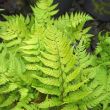
Height: 20 inches
Spacing: 14 inches
Sunlight: partial shade, full shade
Hardiness Zone: 5b
Other Names: Tsu-Sima Holly Fern
Description:
This easy to grow smaller size fern is great for any shaded area of the garden; also an excellent choice for container or indoor growing; dark stems contrast beautifully with the foliage adding tremendous interest; very resistant to pests and disease
Ornamental Features:
Korean Rock Fern is primarily valued in the garden for its cascading habit of growth. Its attractive ferny pinnately compound leaves remain forest green in color with distinctive black veins throughout the year.
Landscape Attributes:
Korean Rock Fern is an herbaceous evergreen fern with a shapely form and gracefully arching fronds. Its relatively fine texture sets it apart from other garden plants with less refined foliage.
This is a relatively low maintenance plant, and is best cleaned up in early spring before it resumes active growth for the season. Deer don't particularly care for this plant and will usually leave it alone in favor of tastier treats. It has no significant negative characteristics.
Korean Rock Fern is recommended for the following landscape applications:
- Mass Planting
- General Garden Use
- Groundcover
- Naturalizing And Woodland Gardens
Planting & Growing:
Korean Rock Fern will grow to be about 20 inches tall at maturity, with a spread of 16 inches. When grown in masses or used as a bedding plant, individual plants should be spaced approximately 14 inches apart. Its foliage tends to remain dense right to the ground, not requiring facer plants in front. It grows at a medium rate, and under ideal conditions can be expected to live for approximately 15 years. As an evegreen perennial, this plant will typically keep its form and foliage year-round.
This plant does best in partial shade to shade. It requires an evenly moist well-drained soil for optimal growth, but will die in standing water. It is not particular as to soil pH, but grows best in rich soils. It is somewhat tolerant of urban pollution, and will benefit from being planted in a relatively sheltered location. Consider applying a thick mulch around the root zone over the growing season to conserve soil moisture. This species is not originally from North America, and parts of it are known to be toxic to humans and animals, so care should be exercised in planting it around children and pets. It can be propagated by division.
605 found, showing page 9 of 41










